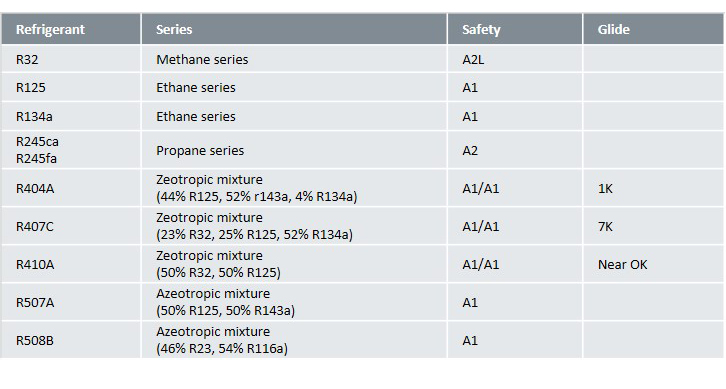Refrigerants
What is Refrigerant?
Refrigerant is a "fluid, that is used for heat transfer in refrigeration systems and that absorbs heat at low pressure and low temperature and releases heat at higher temperature and pressure, while usually a change of state of appearance happens".

Classification of refrigerants
A refrigerant may be either a pure compound like R22 and R134a or a mixture (blend) of two or more refrigerants like R404A, R407C or R502. A mixture can behave either as a pure refrigerant that is named azeotropic mixtures, or differently that is named non-azeotropic or zeotropic mixtures.
According to chemical composition, refrigerants are divided into some groups. Some of these chemical compounds may be harmful to the environment and are being replaced with more environmentally friendly alternatives.
In the following section, we can find different groups of refrigerants, their field of applications, advantage and disadvantage of them.
CFC = ChloroFluoroCarbons
Chlorofluorocarbons are refrigerants that contain chlorine. They have been banned since the beginning of the 90's because of their negative environmental impacts. Examples of CFCs are R11, R12 and R115. The conversion of equipment and systems using CFCs has not yet been completed.
HCFC = HydroChloroFluoroCarbons
The slow phase-out of CFCs shows it is a costly process. However, and more importantly, it also shows the problems and indecisiveness surrounding the availability of HCFCs, which were officially indicated as temporary (until 2030) substitutes for CFCs. The hasty actions of the European Union that culminated in the ban of HCFCs, immediately for refrigeration and after that for air conditioning, has upset the industry's programs and plans. The HCFCs contain less chlorine than CFCs, which means a lower ODP (ozone depletion potential). Examples of hydrochlorofluorocarbons include R22, R123 and R124.
HFC = HydroFluoroCarbons
The hydrofluorocarbons are refrigerants that contain no chlorine and with ODP=0 are not harmful to the ozone layer. However, their impact on global warming is very large compared with traditional refrigerants. The most common HFC refrigerants available since the ban on HCFCs are presented in below Table:

There are some comments on the refrigerants presented in the above table are as below:
- R32 and R125 are rarely used as single refrigerants, but only in mixtures with another refrigerants.
- R245c and R245fa are used almost exclusively in a rather experimental way in the United States.
- As an alternative to R502, R404A has been developed for refrigerators and freezers.
- R134a was the first HFC introduced in refrigeration and air conditioning with great success, because it requires almost no changes in the equipment designed for R22. However, it offers a very limited efficiency, about 40% lower than those systems obtained with R22. Because of lower efficiency of R134a and higher cost of the built units, using of this refrigerant is mainly in systems with high capacity (over 250 kW) with screw and centrifugal compressors.
- R407C is, like R134a, thermodynamically similar to R22 and works. However, unlike R134a, which is a pure compound, R407C has a glide of 7 K, making it barely usable in small residential systems. In the event of a sudden leakage, a 7K glide may result in changes in the proportions of the mixture. Usually, even a standard refill is done, we cannot be sure the new refrigerant mixture has the same proportions as it had before the leakage. Due to its high glide, R407C refrigerant is used only in medium-capacity systems (50-250 kW) and need to be serviced by skilled personnel.

- R410A has very attractive thermodynamic properties, higher energy efficiency than R22, no glide and hence no problem with the mixture remaining after charge loss and refill. However, it has an operating pressure almost double that of R22, and therefore requires a redesign of the whole system and using components with higher operating pressure tolerance. (45 bar)
- R507A is used successfully in industrial and commercial refrigeration.
- R508B is less frequently used in low temperature cycles. R507A and R508B have favorable thermodynamic properties and no problems with temperature glides, because they are azeotropic mixtures.
FC = FluoroCarbons
Fluorocarbons contain no chlorine and are not harmful to the ozone layer. However, they are extremely stable, and they have a high GWP. R218 is an example of a fluorocarbon, and FCs are also present in the mixtures R403 and R408.
HC = HydroCarbons
Hydrocarbons are a very limited solution to the environmental problems associated with refrigerants. They are harmless to the ozone laye and GWP is lower than 5, but they are highly flammable. Isobutene R600a and propene R290 are two examples for HC refrigerants.
NH3 = Ammonia
Ammonia, R717, is an attractive refrigerant alternative. It has been used in refrigeration systems since 1840 and in vapor compression since 1860. In terms of its properties, it should be considered a high-class refrigerant. Furthermore, its ODP and GWP are 0. Ammonia leaks can easily be detected by the smell, ammonia is very dangerous even at low concentrations because the smell often causes panic. This is the main reason why ammonia was use only in huge industrial applications.
CO2 = Carbon Dioxide
R744, carbon dioxide, has several attractive characteristics: non-flammable, does not cause ozone depletion, safety A1 in toxicity index, available in large quantities, and low cost. But for two reasons; low efficiency and high operation pressure, efforts are needed to improve its refrigeration cycle and related technology, particularly heat exchangers and expansion devices.
HFO = Hydrofluoroolefins
HFOs are unsaturated organic compounds composed of hydrogen, fluorine and carbon. These organofluorine compounds are of interest as refrigerants. Unlike HFCs and CFCs, which are saturated, HFOs are olefins, otherwise known as alkenes.
HFO refrigerants like R1234ze are categorized as having zero ozone depletion potential and low global warming potential and so offer a more environmentally friendly alternative to CFC, HCFC, and HFC refrigerants.
There are no products to list in this category.
